I’m recently back from a journey that took me through Russia, Mongolia, China, Tibet, and Nepal (and I’m aware that China considers Tibet an “autonomous region” of China and not a nation in its own right; that China “liberated” Tibet 60 years ago. But nobody - absolutely nobody in their right mind and not brainwashed by the chinese dictatorship - can see the ruthless chinese oppression of Tibet as anything else than a blatant occupation! More on that in an upcoming post).
I visited Russia (Siberia) during very early spring and my photos from that part of the trip mainly boils down to those of leafless birch trees; so I’ll skip Russia and jump straight to Mongolia in this floristic travelogue ;-) I’m in the unfortunate situation that I don’t know the names of most of the plants featured in this post so any help is appreciated ;-)

Cream flowers

Yellow flowers

Light blue / lilac flowers
After spending some days in Ulan Bator (Ulaanbaatar), the capital and largest city of Mongolia, we set out for Gorkhi-Terelj National Park. It was still early spring but a few plants were flowering, including the cream, yellow, and light blue/lilac flowered plants pictured above. Especially the latter was abundant, in many places almost covering the grassy slopes with its beautiful flowers.
My expectations to Gorkhi-Terelj involved imagery of serene, unperturbed nature allowing for days of pure trekking bliss ;-) However the “developed” part of the park we visited is on the verge of being destroyed by golf courts, tourist ger camps, ubiquitous signs and posters, road construction, housing development, and the like. In their eagerness to attract more visitors the very soul of what people are coming to see are being destroyed. It’s a big shame.
That being said it’s still possible to find undisturbed spots among the rolling, grassy hills and beautiful rock formations (in many ways reminding of the monzogranite formations at Joshua Tree National Park) where you can get a sense of being in the wilderness. If you are of an imaginative temperament it’s not even hard to envision Genghis Khan (Chinggis Khaan) galloping across the steppes; otherwise you can go see the (quite clumsy and ugly, yet colossal) Genghis Khan monument ;-)
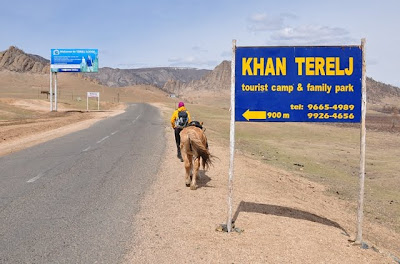
A few of the ubiquitous signs and posters

Road construction near Turtle Rock
Another plant that is abundant in Terelj is (what I take to be) Orostachys spinosa, a cold-tolerant alpine native to Siberia and Mongolia. Its fleshy leaves are arranged in a rosette, growing to 10 cm (4'') in diameter at maturity. The plant is said to be able to survive extreme freezing temperatures down to -40°C. I collected a few of these plants in the hope to grow them on my balcony here in Copenhagen, but unfortunately most of them died off in a storage room in Kathmandu - one small plant is still alive though, so I keep my hopes high ;-)
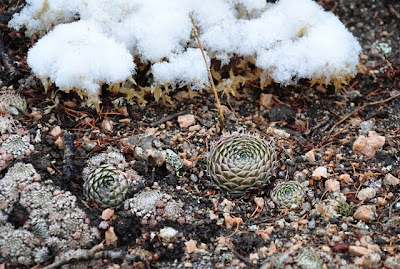
A cluster of Orostachys spinosa
Back in Ulan Bator the only plants we could find were made of plastic. At first I found it a bit strange to have outdoor plastic flower arrangements in a park, but it seemed like a common practice.

Red plastic flowers
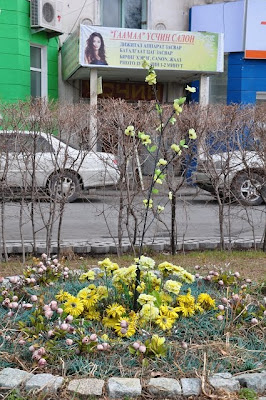
Yellow plastic flowers
Monday, July 04, 2011
Mongolian wildflowers
Wednesday, March 30, 2011
Non-cactus flora of Joshua Tree National Park
Unfortunately I’m not that well versed in the non-cactus flora of the Mojave and Colorado deserts so I’m afraid I don’t know the names of most of the plants featured in this post. If you have more details I would appreciate a comment.
Unknown blue flower in habitat
I was especially fascinated by this small plant growing in the lower Colorado portion of the Joshua Tree National Park. I visited too early in the spring to experience a full blooming desert but this guy was flashing its bright blue flower, standing out among all the earth tones amidst a wash crossing the trail from Cottonwood Spring to Lost Palm Oasis. I studied the plant and its surroundings for a while, intrigued by the habitat it had chosen to grow in - it would for certain be washed away by torrents of water during the next flash flood.
Unknown yellow flower
Another interesting plant displayed this beautiful yellow flower that looks like it might belong to the Fabaceae (Leguminosae) family but I’m not certain.
Unknown yellow flower in habitat
The yellow flowered plant had found a much more secure habitat, growing safely among the boulders in the rock-enclosed Hidden Valley (rumored to have been used by cattle rustlers in the past).
Nolina parryii in habitat
One species I’m pretty sure of is Nolina parrayii (Parry's Nolina or Giant Nolina) that has long thin leaves (and is sometimes called beargrass). It seems to be especially abundant in the lower Colorado portion of the park but also grows in some of the higher Mojave parts like e.g. the aforementioned Hidden Valley.
Nolina parryii seeds
Its tall flower stalk is said to be edible after being baked, with a somewhat bitter taste. Alas, no fresh flower stalks were to be found at the end of February and I didn’t want to try the old dry ones out for taste ;-)
In order to be better prepared I plan to buy the following desert flora books before my next visit to Joshua Tree National Park: Sonoran Desert Wildflowers
Friday, March 18, 2011
Ocotillo (Fouquieria splendens) in Joshua Tree National Park
Near the closing of February I spent a weekend in Joshua Tree National Park. It was my third visit to the park and this time I targeted in on teddy-bear cholla (and of course cacti in general), Yucca brevifolia (one could argue they are hard to miss in the park;-), and another of my favorites that is covered in this post: the ocotillo (Fouquieria splendens) with its sprawling canes soaring for the sky.
Ocotillo flower, close-up
Fortunately my visit followed a period of heavy rains so the ocotillos were both draped in leaves and flowering. On the downside a strong gale was blowing making it extremely difficult to get a clear shot of the flowers (but as the pictures show I finally managed to snap a few;-)
Ocotillo in the Colorado Desert
The ocotillo, characteristic of the Colorado Desert, prefers to root in gravelly slopes of alluvial fans. Flash floods flush sand, gravel, and rock out of the canyons and onto the valley floor creating these fans.
Ocotillo displaying new growth
Fouquieria splendens is sometimes confused for a cacti, but is not. The thorny multi-stem shrub is in fact a woody deciduous plant. Unlike other deciduous shrubs, which normally grow leaves in the spring and drop them in the fall, the ocotillo may grow and drop leaves as often as five times during the year. Its leaves aren’t season dependent but rain dependent.
Fouquieria splendens leaves
Following a sufficient rain, the ocotillo puts forth a cluster of leaves above each torn, adorning the otherwise dead-looking canes with a flourish of green. At the same time red blossoms may appear at the tip of the canes. The leaves go about the business of photosynthesis until the next drought; then they turn red or brown and drop.
Sprawling ocotillo canes reaching for the sky
The above picture was taken standing on the ground looking up into the sprawling canes of an ocotillo. It gives an impression of the height of the plant as I stand 190 cm (6 feet 3 inches) tall and these plants tower above me.
You can find more information on Fouquieria splendens in the book Sonoran Desert Wildflowers: A Field Guide to the Common Wildflowers of the Sonoran Desert.
Saturday, January 22, 2011
Cacti in Crystal Cove State Park
During a recent visit to Orange County I had a weekend to kill. I neither had the energy nor the time to head for the open desert so instead I decided for a stroll at Laguna Beach.
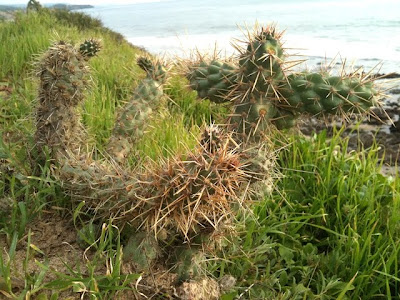
Cylindropuntia prolifera (coastal cholla) overlooking the Pacific Ocean
I never made it to Laguna Beach though. Cruising south on the Pacific Coast Highway I noticed a sign advertising Crystal Cove State Park and decided to check it out.
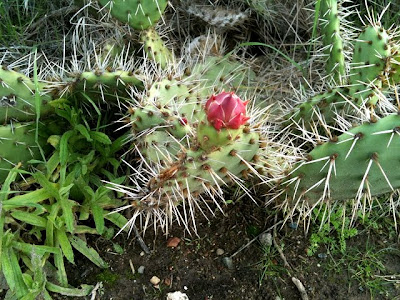
Opuntia littoralis (coastal prickly-pear)
And I’m glad I did - the park turned out to comprise a secluded and pristine stretch of beach, almost completely deserted in spite of its location smack in the middle of the SoCal urban sprawl. And best of all cacti were abundant ;-)
I have to admit I was a bit surprised to see cactus growing that close to the sea - they even grow on the dramatic slopes of the coastal bluffs overlooking the Pacific Ocean. It just goes to show how diverse environments cacti are capable of coping with.
I’m not well versed in opuntioids but according to this Flora of Crystal Cove State Park the Cactaceae growing in the park are Opuntia littoralis (coastal prickly-pear) and Cylindropuntia prolifera (coastal cholla).
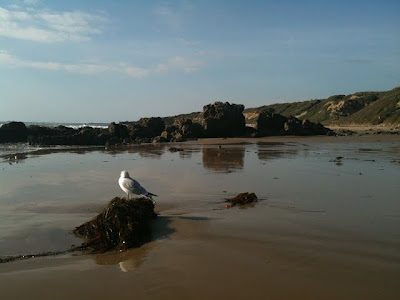
The beach at Crystal Cove State Park
Entering the park I was greeted by a friendly ranger who recommended a hike that takes you down the coastal bluffs and onto the beach - I followed her advice and spent a couple of hours walking the beautiful trails and enjoying the peaceful beach (and of course the cacti ;-)
It was quite magical walking the beach where the only sounds were the rumble of the breaking waves and the squeaking of seagulls, knowing that only a few hundred meters inland you would be engulfed in the ubiquitous noise of cars hissing by.

Tide pool at Crystal Cove State Park
I love the rock formations along California’s beaches, savor the fascinating sea cliffs that have been sculpted by winds and the relentless battering by waves through the ages.

Rock “hoof”
Unfortunately I didn’t bring my Nikon SLR for this trip and my phone is a less than ideal camera, but the pictures will have to suffice.
You can find more information on hiking Crystal Cove State Park in the book California's Coastal Parks: A Day Hiker's Guide.
Sunday, September 23, 2007
In search of Echinocereus reichenbachii in Wichita Mountains Wildlife Refuge
I recently revisited Oklahoma City. Having heard that Echinocereus reichenbachii is abundant in the millions in Oklahoma, I decided to see if I could find some of these fascinating plants in habitat where they occur in many stem forms and spine colors. E. reichenbachii grows in several of the state parks in western Oklahoma, but after a bit of research I decided on visiting the Wichita Mountains Wildlife Refuge. The refuge is within easy driving distance from OKC (head southwest on highway 44 for an hour or so, then take the Medicine Park exit just north of Lawton) and apart from cacti it also boasts a rare remnant mixed grass prairie, an island where the natural grasslands escaped destruction thanks to the granite outcrops rendering the land impossible to plow.

A cluster of Echinocereus reichenbachii var. albispinus
All the Echinocereus plants I found were of the variety Echinocereus reichenbachii var. albispinus (or Echinocereus baileyi if you consider it a full species). It seems like the plants prefer to grow in fissures in the granitic rock, especially if moss is also growing in the fissures.

E. reichenbachii var. albispinus growing in moss
The pictured plants are growing in the open prairie grasslands south-east of Mount Scott. It’s quite amazing that most of the plants seem undamaged by the grazing herds of bison and longhorn; I would expect such a large animal could trample an Echinocereus underfoot without even noticing it, but that doesn’t seem to be the case.

Grazing bison
I also saw a few Opuntia plants – probably O. phaeacantha – with beautiful carmine-red fruits. The pictured plant is growing on the southern bank of Quanah Parker Lake; named for the Quanah Parker of Native American Church fame.

Fruiting Opuntia sp. (O. phaeacantha?)
The Wichita Mountains Wildlife Refuge is a very interesting place to visit and I wish I had had more time (unfortunately I had to deal with delayed baggage, limiting the visit to half a day). It comes highly recommended if you are looking for Echinocereus reichenbachii var. albispinus (= Echinocereus baileyi) or bison ;-)
You can find more photos from my visit at http://public.fotki.com/WichitaMountainsWR/.
Wednesday, November 23, 2005
Grand Canyon Cacti
Heading north on Arizona state route 64 from Williams, AZ and driving through Kaibab National Forest, it’s hard to imagine the earth split wide open. When you are standing at the Grand Canyon rim you have to acknowledge that your imagination not always suffices.
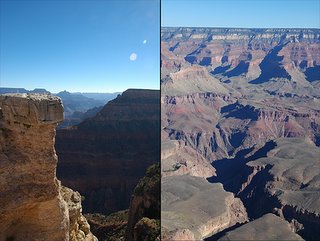
View from Mather Point
I went down the canyon, following the Bright Angel Trail to Plateau Point. On the upper part of the trail the cactus vegetation was rather sparse, but after having passed the Indian Gardens and entered the Blackbrush (Coleogyne ramosissima) dominated desertscrub on the Tonto Platform, the cacti became abundant.
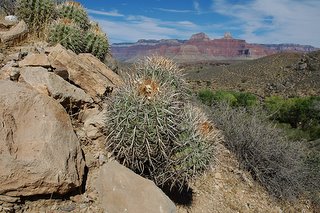
Echinocactus polycephalus overlooks the Tonto Platform
Especially Opuntias are massively present, almost covering the ground in some areas. I collected some Opuntia polyacantha var. hystricina seeds (thanks to the friendly people at the cacti_etc mailing list for helping me getting the name correct). The seed donor is depicted below.
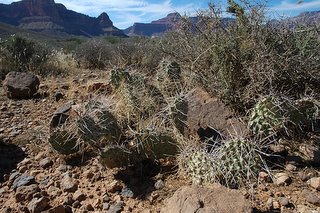
Opuntia polyacantha var. hystricina
I’m aware that it’s absolutely stupid to sow cactus seeds at this time of year (in the Northern Hemisphere, that is ;-), but I couldn’t resist the temptation of testing the viability of the seeds. Prior to sowing I soaked the seeds for 14 days and after an additional two weeks in the ground 50% of the seeds have now germinated. I expected the seedlings to be “leggy” but was a bit surprised to see what looks like a tricotyledon?
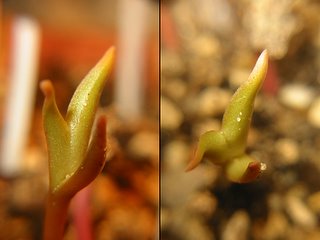
Tricotyledon Opuntia seedling
The Grand Canyon hike took place September 24, 2005. Additional photos can be found at Grand Canyon Cacti & Succulents.
Sunday, January 02, 2005
test
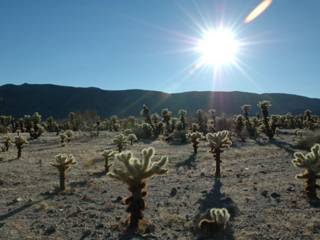
A field of Cylindropuntia bigelovii photographed during a recent visit to Joshua Tree National Park.
Unique search string: snyrf smldsfiope
Technorati claim token K25998WZJ3QY
All Time Most Popular Posts
-
Lophophora williamsii (peyote) populations have diminished in large areas of South Texas where peyoteros harvest the cactus for ceremonial ...
-
On various occasions I've been asked what growing media I'm using for my cactus plants. I don't have a set soil mix recipe as su...
-
Below is a list of retailers/nurseries selling cactus seed and plants. I've only listed vendors I've done business with. If you ar...
-
Most cacti are easily grown from seed - and with a little patience and care they can be grown into beautiful plants. Lophophora williamsi...
-
In last month’s post on the troubled Texan peyoteros I referred to Anderson’s article on the peyote situation in Texas. Given the importanc...
-
Yet another slightly off topic and probably not entirely politically correct post, but I couldn’t help noticing the similarity of my monstr...
-
Flowering stand of San Pedro cacti (Trichocereus pachanoi) To me the main draw of the San Pedro cactus ( Trichocereus pachanoi (syn. Ech...
-
In the June 2008 issue of the Cactus & Co magazine Jaroslav Šnicer, Jaroslav Bohata, and Vojtěch Myšák described a new Lophophora spec...
-
There seems to be an increased focus on the alarming Texas peyote situation. A couple of weeks ago the Houston Press published a mournful, i...
-
I spent two weeks working in Delhi, India during January. I had one weekend off and had planned to spend it in Delhi at my own leisure, but ...






























